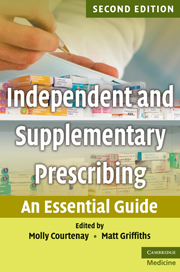Book contents
- Frontmatter
- Contents
- List of contributors
- Foreword to the second edition
- Preface to the second edition
- 1 Non-medical prescribing: an overview
- 2 Non-medical prescribing in a multidisciplinary team context
- 3 Consultation skills and decision making
- 4 Legal aspects of independent and supplementary prescribing
- 5 Ethical issues in independent and supplementary prescribing
- 6 Psychology and sociology of prescribing
- 7 Applied pharmacology
- 8 Monitoring skills
- 9 Promoting concordance in prescribing interactions
- 10 Evidence-based prescribing
- 11 Extended/supplementary prescribing: a public health perspective
- 12 Calculation skills
- 13 Prescribing in practice: how it works
- 14 Minimising the risk of prescribing error
- Index
- References
12 - Calculation skills
Published online by Cambridge University Press: 10 January 2011
- Frontmatter
- Contents
- List of contributors
- Foreword to the second edition
- Preface to the second edition
- 1 Non-medical prescribing: an overview
- 2 Non-medical prescribing in a multidisciplinary team context
- 3 Consultation skills and decision making
- 4 Legal aspects of independent and supplementary prescribing
- 5 Ethical issues in independent and supplementary prescribing
- 6 Psychology and sociology of prescribing
- 7 Applied pharmacology
- 8 Monitoring skills
- 9 Promoting concordance in prescribing interactions
- 10 Evidence-based prescribing
- 11 Extended/supplementary prescribing: a public health perspective
- 12 Calculation skills
- 13 Prescribing in practice: how it works
- 14 Minimising the risk of prescribing error
- Index
- References
Summary
The National Prescribing Centre (NPC) has developed competence frameworks for non-medical prescribers to assist with the maintenance of competence (NPC 2001; 2004; 2006). Each framework contains a section on prescribing safely in which one of the elements is ‘checks doses and calculations to ensure accuracy and safety’. Anyone who is to check calculations performed by others must first be competent to perform such calculations. This is the most obvious element of the framework calling for competence in calculation skills. However, there are other skills called for in which competence in calculations is implicit in performing the role of a prescriber. For example, the prescriber will have access to a drug budget and must make sure that their prescribing is cost effective. The competence document makes reference to critical appraisal of literature, which will inevitably involve at least a minimal understanding of the statistical terms used by the authors. The prescriber should understand the pharmacokinetics of medicines and how changes, such as age and renal impairment, affect dosage. Again, this may require an ability to understand and utilise pharmacokinetic data.
The prescriber should know about common types of medication error and how to prevent them. The Chief Pharmaceutical Officer recognised calculation error as a key risk factor in the medication process in his 2004 report Building a Safer NHS for Patients: Improving Medication Safety (Smith 2004). The incorrect application of dosing equations is considered a major contributor to preventable adverse events associated with the prescribing of medicines (Lesar 1998).
- Type
- Chapter
- Information
- Independent and Supplementary PrescribingAn Essential Guide, pp. 147 - 179Publisher: Cambridge University PressPrint publication year: 2010



